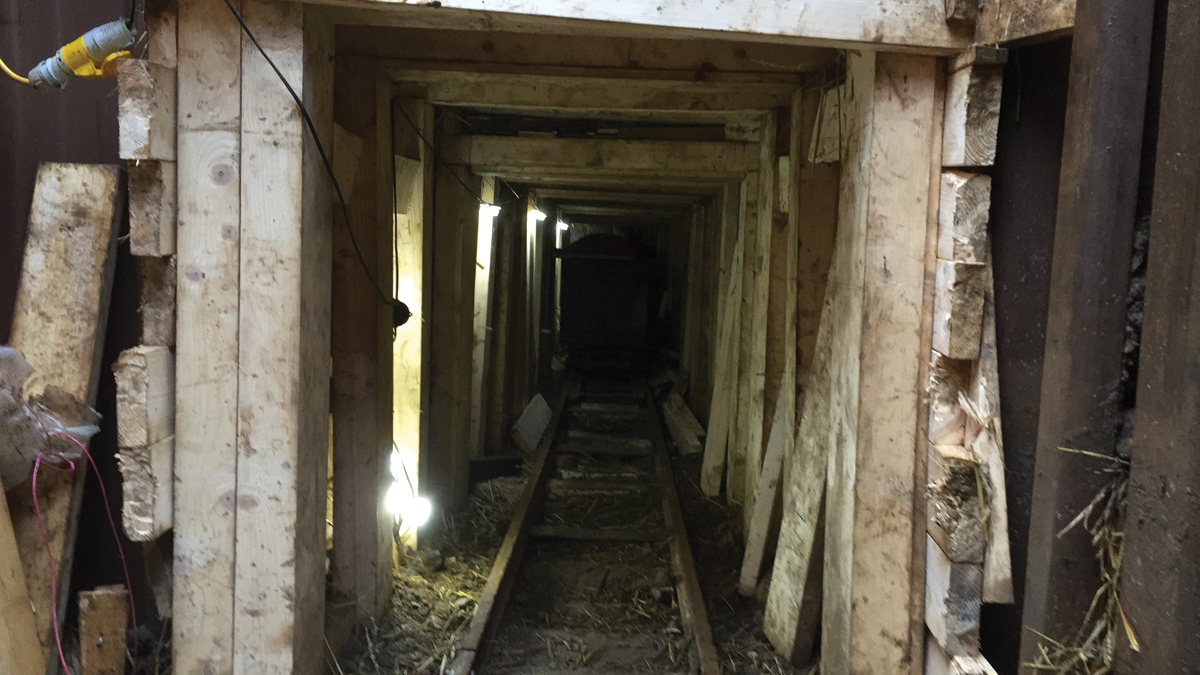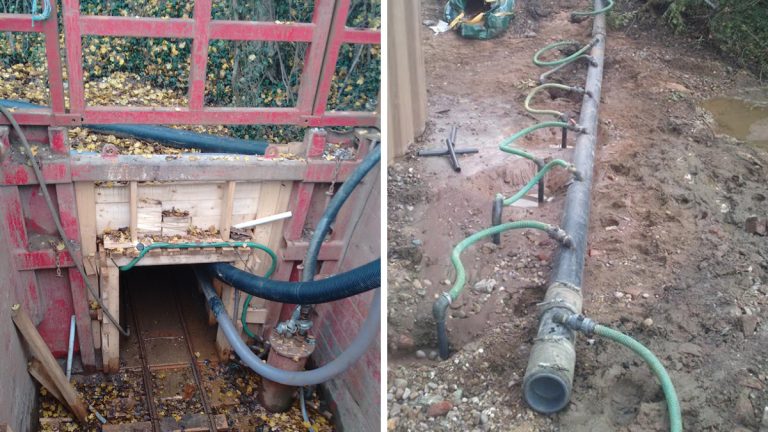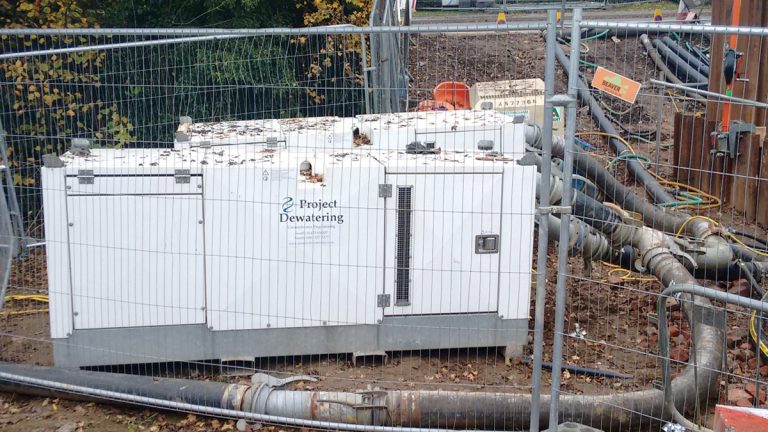Hassocks Lane (Beeston) Sewer Requisition (2016)

Surface water sewer connection - Courtesy of NMCNomenca (now Galliford Try)
Bellway Homes Ltd submitted an application for foul and stormwater sewers requisition under Section 98 of The Water Industry Act 1991 for a new housing development in Beeston, Nottingham. With no pre-existing drainage on the site it was necessary for the drainage from the 128 new properties to extend across 3rd party land and into the nearest public sewer. With the only available surface water sewer being in the entrance to the Royal Mail Nottingham Primary Sorting Office, and foul connections at incompatible levels, the only viable option for Bellway was to submit a requisition to Severn Trent Water to lay the new connections. Severn Trent appointed their framework design and build contractor, NMCNomenca (now Galliford Try), to carry out the work. To complicate matters further, the housing development was part way through construction when the sewer requisition started.
Surface water connection
With the only viable connection point for the new surface water drainage being in the entrance way to the Royal Mail Nottingham Primary Sorting Office discussions were immediately started with this stakeholder. It quickly became apparent that any form of open cut works in the entrance are completely unfeasible due to the daily £1m impact on Royal Mail operations and corresponding compensation cost to Severn Trent Water. The team set about exploring alternative options, focusing on innovative no-dig techniques.
Mainstream no-dig techniques such as directional drilling were ruled out due to the added complexity of shallow gradients, and despite the minimal disruption from auger boring, the extremely confined Royal Mail site provided no space for reception pits.
Through collaboration with sub-contractor Active Tunnelling Ltd a timber heading design technique was developed, allowing the new surface water sewer to be constructed entirely from within the adjacent development site with no excavation required in the access road.
A connection was formed into the existing manhole by breaking out 1.5m of concrete surround from within the timber heading before laying the new pipe back to the development. The only work required within the Royal Mail access was to enter the existing manhole to rebench and reinstate the connection, a short duration activity that was planned around the Royal Mail operations to avoid disruption their operations.
To add to the complexities of the scheme, the site is in an area of former railway sidings with a long history of industrial use which has left the ground and shallow strata contaminated with fuel and other pollutants. In order to tie into the public surface water sewer, the proposed sewer route ran almost entirely within the contaminated soil, and thus careful consideration had to be given to material handling and operatives’ welfare on site.
Full respiratory masks, rather than air circulation, were required in the heading to supply clean air to the operatives due to the concentration of fuel fumes entering the excavation from the surrounding soil. 40 tonnes of contaminated ground had to be taken off site, treated and then recycled.
High groundwater levels where encountered during the timber heading; the water was pumped out of the timber heading in similar fashion to the oxygen supply through a tube network into the developers balancing pond.

(left) Foul water connection and (right) dewatering network – Courtesy of NMCNomenca
Foul water sewer solution
An existing foul water sewer ran through the developer’s land from the nearby fire station which could not be connected as the level was higher than developer’s drainage; this sewer ran directly above the line of the proposed sewer as the developer had constructed its sewer system parallel to the existing, meaning the sewer had to be worked around in the timber heading pit.
The existing sewer above, coupled with protected trees along the site boundary precluded the use of conventional open cut techniques. Guided auger bore was the next favoured solution; however congested services between the site boundary and connection manhole meant that there was insufficient space for a reception pit, ruling out this option as well.
The depth of the foul water sewer connection was 5.05m deep due to the developer’s drainage levels, and whilst this had the benefit of being below the band of contaminated ground it placed the excavation below the groundwater level in running sand. It was therefore necessary for continuous dewatering whilst the timber heading was excavated and the pipe constructed.
Dewatering was designed and supplied by Project Dewatering, and comprised 21 (No.) well points along the line of the excavation along with a sump pump within the heading itself.
The high volume of heavy good vehicles from Royal Mail and surrounding businesses at all hours meant that works in the road needed to be kept to a confined area allowing a constant flow of give and take HGV traffic to pass the works. A single lane closure was used to install well points for the foul water timber heading which were then buried under road plates so the lane could be reopened.

Dewatering pumps – Courtesy of NMCNomenca
Sustainability and engineering principles
An auger boring technique was discounted on both connections to reduce disruptions to all stakeholders on the adjoining business estate; drive pits would have increased the duration of invasive works on traffic sensitive roads.
The methodology of timber headings was selected for a multitude of reasons; particularly a substantial reduction in the volume of contaminated material being taken off site.
By using this technique it also mitigated all impact on protected trees which were desired to be retained as a boundary between development and industrial estate.
The lifetime of the sewer was a crucial part of determining the material and sizing of the sewers; they were designed to allow for future increase in flows preventing the need of further works in this challenging area. PE pipes were selected for their substantial longevity in comparison to other materials. The PE pipes were also beneficial to use on the scheme as they were easier to manoeuvre in poor ground conditions and tight working widths and around protected trees.
Project management and procurement
Communication between all stakeholders was crucial in ensuring each party’s needs was satisfied. To derive a solution NMCNomenca liaised with Royal Mail to determine their expectations and requirements to maintain their regular business operation. Communicating with the housing developer throughout the design phase and construction phase was essential into mitigating risk whilst both sites where live.
North Midland Construction’s ongoing partnership with Active Tunnelling allowed the design of the project to accelerate using their expertise in timber heading; they confirmed the feasibility of the design frequently as factors influenced the changing design during the site investigation stage.
Another outstanding example of communication with the scheme was the great working relationship NMC have with Nottinghamshire Highways. The high volume of works in the Beeston area due to the recent tram construction and resurfacing works meant that works in the highway in the area had to be carefully planned in liaison with the highway officer; the solution using road plates to hide the well points was derived from this communication.
Innovation
For a project of this size, the sustainability of the project from a business and environmental point of view and stakeholder satisfaction, which could have easily been sacrificed for profitability, where impressive attributes of the project. Using an inherently risky construction technique effectively we achieved our goal by striving to satisfy all stakeholders through our customer and communities first mind-set.
Whole project impact
Severn Trent Water strongly embody its programme, customers and communities first and acting as a representative of Severn Trent Water, NMCNomenca strive to deliver a great customer service by meeting and exceeding all expectations.
NMCNomenca was proactive with its construction technique by using trenchless solutions to avoid any complications with surrounding companies regarding road closures. Minor carriageway incursions that did occur whilst proving services and installing dewatering wells were successfully communicated early to clients through customer letters. The construction satisfied all stakeholder’s involvement.
By sizing the sewers to allow for redundancy the whole life impact of the asset is reduced by minimising the chance of future works to increase the capacity in the event for further development upstream.
Construction started on site in September 2015 and was completed in December.




